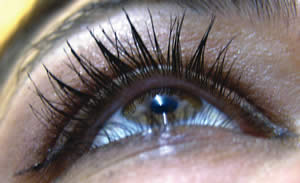The eye can be compared to a camera. The anterior portion, which is the part we see when we look into our eyes (cornea, sclera, crystalline), corresponds to the objective. The film corresponds to the retina.

It is formed of many layers of cells linked together in a highly precise manner. It has the most particular characteristic of transforming the light impulse that reaches it through the pupil in a nerve stimulus which is sent to the brain through the optical nerve.
This function of transfer is however extremely demanding on the cells and requires an important level of energy. There are no problems for a young cell, but when it begins to mature this demanding work is more severe, the cell becomes older and dies. The cells are devoid of regenerative capacity and their number substantially diminishes.
From a hundred million cells during teenage years, they diminish to 75 millions at the age of 70. If the cell is constitutionally weak, ageing happens early.
This process of early ageing limited to the retina is substantially at the basis of all forms of retinial degeneration which are characterized by the more or less precocious death of a higher number of cells and therefore, of a proportional reduced sight.

Of course the phenomenon is limited to the retina since the subject can maintain a wonderful physical and mental health.
Retinitis pigmentosa is a disease caused by genetic alterations, in other words the DNA. Even the ageing process is genetic: if one has parents who have a good longevity, chances are this person will live a long time: it's a matter of DNA.
If we imagine the cells of the retina like houses where the inside room has engineers and technicians working on planning and preparing every aspect of a house from the brick to the windows which are then assembled to build a home, we have a good exemple of what genes do: they design and build every detail used in building a home.
If one of the engineers or technicians doesn't plan or assemble properly one of the particular pieces for construction, the walls, windows, roof and plumbing of the house will have weak points.
These weak points will entail more or less important downfalls which can create unreliability and unstability for the home.
This is exactly what happens in a cell when one or more genes are no longer able to build proteinaceous enzymes or a structure necessary to the cell.
It is now known that genetic destiny cannot be changed; vice versa, external agents contribute significantly to lengthen or shorten the life of a home with construction defects.
In fact, if the home is exposed to rain, wind, sun or humidity, damage will happen earlier to the structural partitionings; if, on the contrary, negative treatment is avoided on the home, it will last longer.
Even for the cells of the retina, life will be longer if exposure to risk factors is avoided: light and the well-known free radicals or if useful substances and nutrients have been given to the cell for its stability.
For exemple, in specific forms of retinitis pigmentosa, in which are lacking the genes responsible for bringing and using vitamin A, it is therefore useful to take some of this vitamin taking care to verify dosage in the blood in order to avoid overdosage.
It is also appropriate to use determined molecules which improve the cell's oxidation capacity (such as Levocarnitina commonly adopted to improve muscular performances). A sort of revolution derives from the possibility of clinical use of particular molecules: the growth factors.
It is a wide class of proteins which action has been detected by Levi di Montalcini; we could define them as the molecules of life because they efficiently prevent the death of cells in crisis. In technical terms they are called anti-apoptotic molecules. Cardialogists, dermatologists and neurologists are making an increasing use of them: infarcted hearts, damaged epidermis, brains with degenerative pathologies have been benefitting from them for only a few years.
At the experimental level, if they are administered in eyes with retinitis pigmentosa, they can block its evolution. Stem cells represent potential therapies also for other degenerative diseases, but for the retina, however, applications are not yet without constraint.
It will certainly not be possible to heal from genetic trouble as it is not possible to cure diabetes by taking insulin, but the evolution of the disease can be slowed down more or less significantly. In fact the decisive therapy will only be genetic.
Molecular genetic is particularly important as it allows today to find the exact location of the anomalous gene and therefore the precise defect in its make up in about 85% of patients. It is an important step towards the eventual substitution of the affected gene.
Already, the identification of the gene allows in a certain percentage of cases the implementation of more interesting therapies. The simple medical genetics, that is the study of the genealogical tree, is also useful. Finally, it is necessary to emphasize how the risk of affected descendants is greater when parents have married between blood relations.
There exist numerous forms of retinitis pigmentosa and even within the same family it is possible to have various symptomatologies. The most characterized symptom is however HEMERALOPIA, that is a reduced visual capacity in bright lights: children who stop playing at sunset; orientation difficulties when entering dim environments, for exemple in a movie theatre, etc.